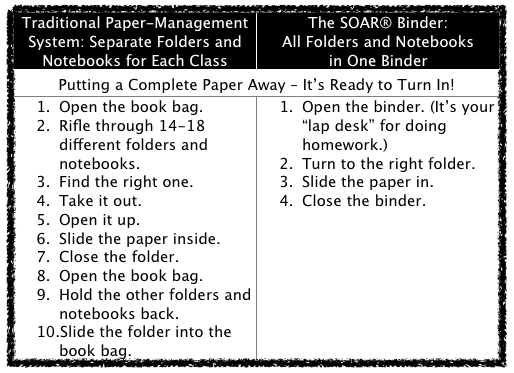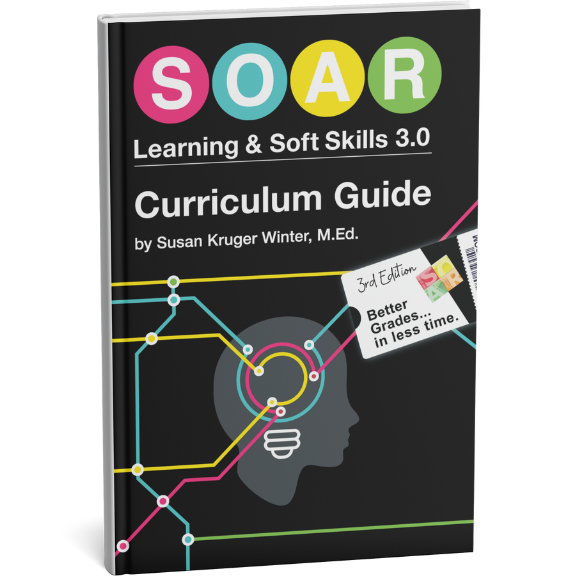The ADHD Circuit® (Article 6): How to Avoid the “Tasmanian Devil Tailspin” of School Work
Have you ever seen a dog chase its tail? The dog keeps going round and round, presumably thinking that, any moment now, he will actually catch that tail behind him. He expends a lot of energy, but has nothing to show for it.
People with ADHD often describe a similar sensation of spinning around in circles. This how students feel with nearly every task related to school: organizing and managing papers, assignments, time and due dates, reading textbooks, taking notes, studying for tests and even, taking tests.
The brain is pretty overwhelmed as it tackles these tasks. When it finally manages to “get started,” the frontal lobe sends a neuron signal, hoping to find a receptor. The other sections of the brain respond haphazardly, like wave at baseball game that is *trying *to get started.
Some sections of the brain receive the signal. Other don’t. The sections that do, stand up one-by-one, check it out, but can’t make sense of it. One by one, they sit back down. The signal is literally left hanging. Nothing will connect.
So, the frontal lobe tries again. The same, sporadic pattern follows and repeats. Again and again. It’s no wonder a person with ADHD feels like they are spinning in circles; this is quite literally what the neurons in their brain are doing!
How to Avoid the “Tasmanian Devil Tailspin” of School Work
In order to manage school work efficiently and effectively, the brain needs a recognized pathway. This is true for EVERYONE, but people with ADHD are particularly susceptible to The Tailspin. People with ADHD also need those pathways to have as few intervals (or “lights in the ADHD Circuit®”) as possible to reduce the impact of “power outages” when neuron circuits fail to connect.
How Do You Establish a Pathway?
With study skills! Big surprise, eh? GOOD study skills will establish a pathway for common learning and organizing tasks. The key is to establish clear, efficient, and effective pathways so the brain has a crystal-clear map to follow.
Which Map Would You Prefer?
Imagine you have arrived at Auckland International Airport. You will be staying at the Cosy Kiwi Bed & Breakfast. You have secured your rental car and are about to exit the airport. Which map would you prefer?
Obviously, Map A, with clear, defined pathways is going to be easiest to read while you are managing an unfamiliar rental car, in a brand new city, in a totally foreign country. Map B would work, but is not nearly as efficient.
By definition, both of these pictures are maps. But, for the specific goal of reaching Cosy Kiwi, they are not created equal. Same goes for study skills.
Not All Study Skills Are Created Equal
Most study skills you will find on the internet are either:
-Not time-efficient.
-Not effective.
-or-
-Both.
Most of them are, in fact, “study skills,” but they look a lot like Map B; a meandering, jumbled, and confusing mess of pathways. GOOD study skills should be like Map A that has a clear starting point and has marked a very clear, efficient path.
For example, I just pulled one of the dozens of study skills books I own off my shelf. In this book, one of the units is titled “Graphic Organizers and Charts.” Hmm…Okay…So what?
The starting point is not clear. Students do not look at this know when to *use* graphic organizers and charts. They need a starting point that matches situations in which they find themselves, such as “How to Read a Textbook,” or “How to Study for a Test.”
When I am standing at the Aukland Airport and want to get to Cozy Kiwi, I can clearly find the Aukland Airport on Map A. With the other map, I have to hunt, search, and squint to find the Aukland Airport.
Students do the same thing; they can learn about a graphic organizer, but they scratch their heads wondering how they are supposed to use it. There is nothing wrong with graphic organizers, but a much more effective title would be, “How to Read Textbooks Using Graphic Organizers.”
Speaking of reading textbooks…this same book needs 67 pages to teach the process of reading textbooks. I know for a fact that a *very effective* method for reading textbooks can be described in four pages…probably even less! Which leads to the next point…
Study skills should be efficient! Map B is NOT efficient. It illustrates, in a jumbled and hard-to-read way, every single route you can use to get to Cozy Kiwi…and every other destination in Aukland. On the other hand, Map A illustrates the most efficient route. Once again, which map would you rather use?
Study Skills and The ADHD Circuit®
Over the last 15-20 years, I have read countless articles and books about best-practices for managing schoolwork with ADHD. To be honest, all of these “best practices” have been pretty vague, but I have always been able to nod and say, “SOAR® does this.” And, “Yup, SOAR® does that.” However, I didn’t understand recently, why SOAR® was so ADHD-friendly.
The ADHD Circuit® clearly illustrates that the fewer steps we have in any given task (circuit), the less likely someone with ADHD is to have a neuron circuit break. It is a biological and mathematical fact that there is an inverse relationship between the number of steps involved in learning/organizing tasks and the level of success students with ADHD will achieve with them; the fewer steps, the greater the chances of success.
Of course, I did not understand this concept when I was first teaching study skills in college, but I *sensed* it. I discovered that the more I could hone in on the specific objective and eliminate seemingly inconsequential steps, the easier a task was and the less stressed I felt. I clearly preferred the path of least resistance! (I have yet to meet any student -or human- who doesn’t.)
So, I pruned the study skills and organizational strategies I was learning and using; I pared them down as much as possible so I could save time and feel less stressed. I now understand that there was a biological reason why that pruning was so important.
To give you an example, Let’s take a look at the difference between the “traditional” method for organizing papers and the SOAR® Binder system. On the chart below, I have honed in on ONE very specific sliver of time when a student is doing homework. In this instance, the student has completed his homework and needs to put it away:
If you assigned each of these steps to lights on The ADHD Circuit®, you would see that number of intervals between steps (neuron connections) is dramatically reduced with the SOAR® Binder. As a matter of fact, the SOAR® Binder has 60% fewer steps than the traditional method. When you account for the compounded problem of traditional systems having 14-18x more supplies, the SOAR® Binder is literally 1000% more efficient!
The ADHD Brain Circuit Needs Pathways
When we were in college, we noticed foot paths were always being forged across the grass in various places around campus; students were naturally forging the shortest paths to reach their destinations. When were returned to school each fall, last year’s foot paths were now freshly-poured cement sidewalks. The university paved the newly forged foot paths EVERY summer, without fail. (We wondered how long it would be before the university was fully covered in concrete, but I digress…)
Brains do the same thing…for repetitive tasks, they follow the same neuron pathways over and over again until those paths become rigid, like a cement sidewalk. This explains why Mom, on the days she would drive us to school, would always forget to turn left on Silvery Lane; her neuron pathway was hard-coded to stay straight on Cherry Hill, heading towards her office. (I hope that makes you feel better, Mom!)
People with ADHD are especially susceptible to rigid pathways, for better or worse. (The “worse” part explains why people with ADHD can get “hyper-focused,” but that’s a topic for another article on another day.) In the realm of managing learning and organizing tasks, people with ADHD can take advantage of these natural tendencies and create rigid pathways, intentionally, with study skills. Effective and efficient study skills.
Conclusion
Students, especially students with ADHD, don’t need to continue chasing their tail in vain! *Good* study skills stop the spinning by mapping out clear, efficient, and effective pathways in the brain. At the start, the efficiency of these pathways reduce the impact of severed neuron connections. Over time, those pathways become less susceptible to broken neuron connections as they become hard-coded in the brain. Study skills are one of the most powerful set of tools for ALL students, but they can especially help students with ADHD thrive!
-Susan Kruger
Other ADHD Circuit® articles can be found here:
Article 1 – The ADHD Circuit® (Article 1) Introduction to the ADHD Circuit®
Article 2 – The ADHD Circuit® (Article 2): A Breakdown of the ADHD Circuit®
Article 3 – The ADHD Circuit® (Article 3): My Personal Journey Through The ADHD Circuit®. . .for a Cup of Milk!
Article 4 – The ADHD Circuit® (Article 4): ADHD Is Not an Excuse!
Article 5 – The ADHD Circuit® (Article 5): Is it Creativity…or ADHD?
Article 7 – The ADHD Circuit® (Article 7): A Simple Learning Solution Hiding in Plain Sight
Article 8 – The ADHD Circuit® (Article 8): “EVERYTHING Is Wrong With My Kid!”
Article 9 – The ADHD Circuit® (Article 9): Improving Social Skills
Article 10 – The ADHD Circuit® (Article 10) When ADHD Children have ADHD Parents
JL041315
Six Steps
Conquer the Chaos
Get Our Free Guide & Information on...

"*" indicates required fields
Get Our FREE Curriculum Guide!
The SOAR® Curriculum
The most critical learning, organizing, and communication skills needed for school. Learn more here.
Who’s Using SOAR®?
SOAR® Guarantee
Click here to learn more.






